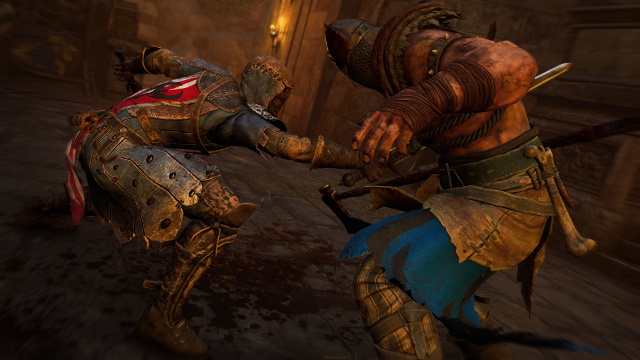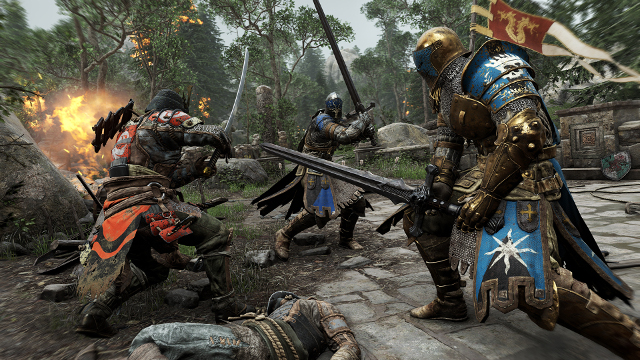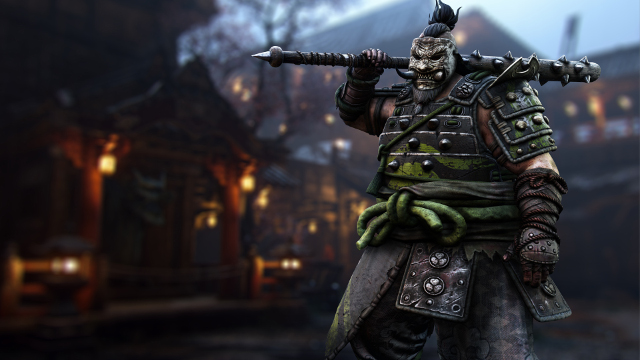I don’t know about anyone else, but I’ve always had a recurring dream where my macho viking tribe decimated a faction of ironclad knights with a few swings of our massive axes. And just like that dream, Ubisoft’s For Honor thrusted me into a completely fictional world where knights, vikings, and even samurai fight tooth and nail in order to fly their colors on every inch of land possible.
Although that concept may be brutal, that doesn’t mean it’s barbaric. For Honor may be violent on the surface, you just have to dig a little to get to it’s somewhat strategic core. Every time I found myself in mid combat I couldn’t just hack my way to victory, I had to evaluate who I was facing, and do my best to block, parry, and counter my way to victory.
A Game of Checkers
The fundamentals of For Honor incorporates your basic fair that many action games include, you have your blocks, parries, small hits, big hits, throws, and whatnot that create a complicated game of checkers between two warriors. What’s slightly different this time around is the how these moves are influenced by the position of your guard, which is controlled by the right thumbstick.
Instead of looking to counter and hit back, you can use your guard stance to invite an attack, parry, and hit back. There are plenty of scenarios that can happen with the level of depth provided. You’ll also have to take character attributes and weight into consideration, as each faction has different ‘heros’ like the heavy samurai Shoguki or the assassin-like knight’s Peacekeepers.
Each character has unique strengths and weaknesses, when I first took control of the peacekeeper I was enamored by the speed I possessed. When taking on enemy heavies I could get in multiple hits while being nimble enough to dodge their big swings. But I lost more than a third of my health with each hit that did land on my fragile frame.

And yes, I did mean checkers earlier, not chess. For Honor’s combat system is complicated, especially for new players, but not so much so that you can outsmart other players every time you match up in battle. Many of those duels will come down to reflexes and team advantages. Several times throughout the multiplayer session, someone on my team would die at the start of a match, allowing the other team to gang up in a 4v3 scenario that almost always ended in defeat.
Multiplayer
For Honor was first announced as a multiplayer only game, so the modes and incentives Ubisoft has set up are quite extensive. You can take on other fighters in one on one duels, join up with other players in games of team elimination, or capture various points in the objective based dominion mode.
The modes are simple, either kill the entire team or capture the objectives long enough to gain enough points so you can kill the other team permanently. That simplicity allows for an additional layer of team strategy that players can form on top of their fighting style.
During the matches that I played, team strategy quickly changed from all around confusion on both sides, to a couple dominant strategies that we decided to stick to. Each elimination round starts out with one on one battles between warriors spread out across the map. Instead of fighting immediately, we found it best to quickly retreat and attempt to regroup somewhere else on the map.

If we managed to take out just one of the other team, that would pt the odds in our favor, we found the best way to approach that was to regroup. As the individual duels are reliant on individual skill, so it was a toss up, if you lose the initial duel the rest of your team will be left with a huge disadvantage.
There are a lot of possibilities for strategies over the different multiplayer modes, but I’m sure dominant ones will emerge as players learn the nuances of each map, hero, and game mode.
Beyond individual matches is the war raging between the three factions, you’ll pledge your allegiance to one of three before jumping into online matches. And based off multiple six hour turns, two week long rounds, and 10 week seasons the map will whose dominating on the battlefield most.
Post launch content will be determined by the victor in each war season, new maps and cosmetic content will be released across all platforms. So while PS4 players cannot play directly with PC players, their battles will both directly influence the same faction war.

Now, I never felt more powerful than taking control of the samurai faction’s Shugoki, a heavy set warrior with slow yet very powerful blows that could decimate smaller warriors with a few strikes. And yet, that feeling wore off rather quickly, after playing the game for nearly four hours I felt that I had grown tired of the core mechanics of the game. I could tell that I wouldn’t enjoy playing more than an hour at a time, and not much more beyond a handful of sessions.
I could be frustrated with the composure of the teams I played with, I could be frustrated with the level of skill I was playing at. No matter what the case, my enjoyment began to shrink from ecstatic to “yea, this is alright,” over the course of a few hours.
As time went on I got tired of the core mechanics of the game, these were things that you are supposed to be doing thousands of times throughout each session. I’m not saying that you won’t enjoy this game if you’re excited for it, but I will that everyone else should try for the closed beta coming in January.







